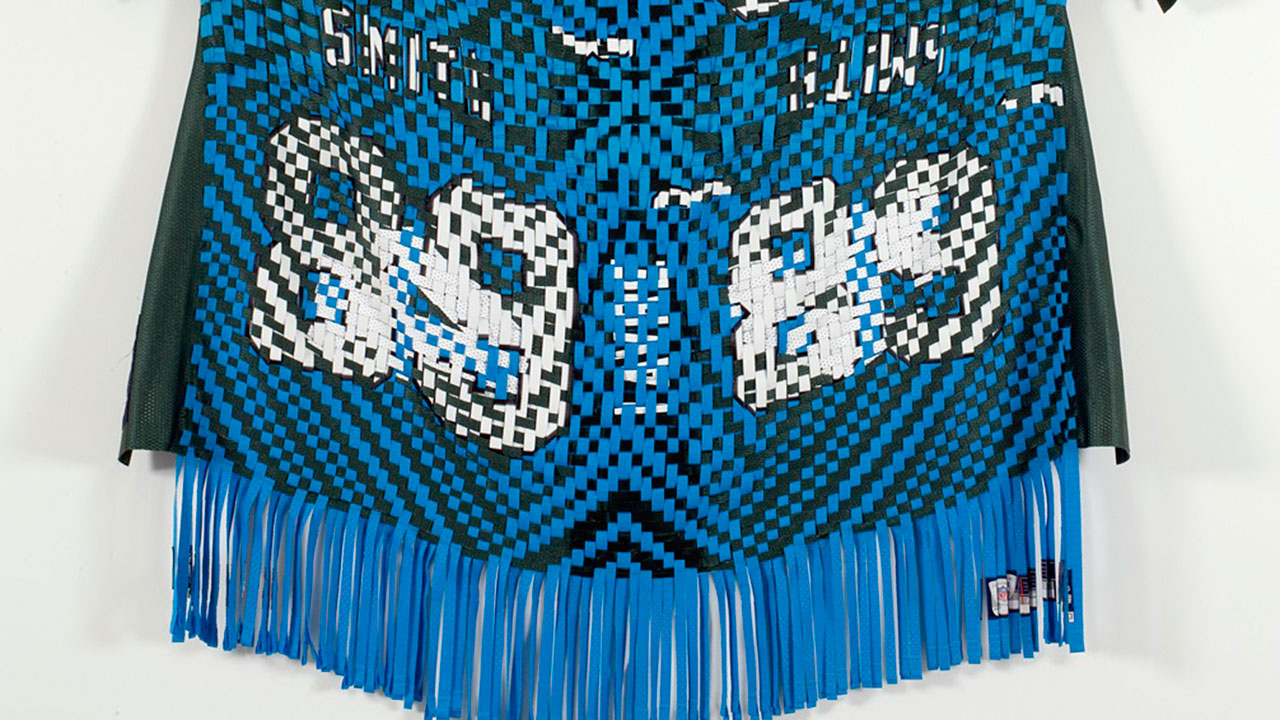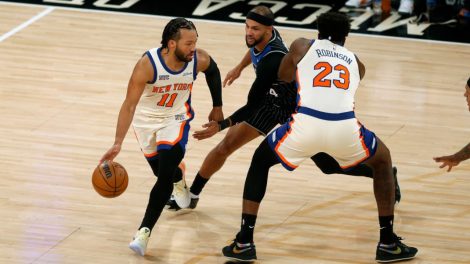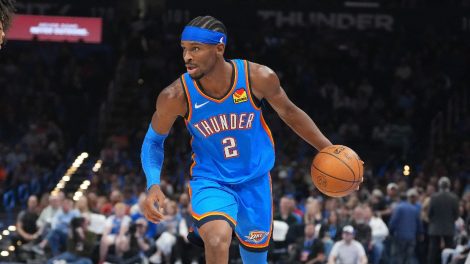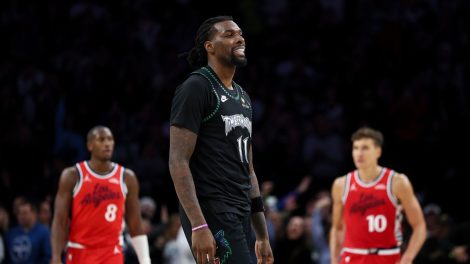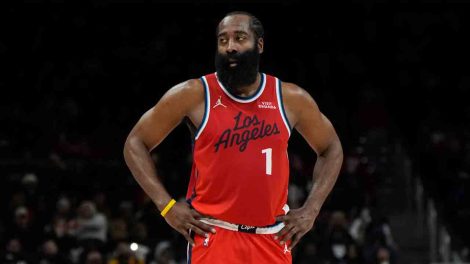What is the relationship between sports and art? How do you juxtapose the history of native art in Canada with modern day references? Indigenous artist Brian Jungen tackled all of these complex issues in his exhibit, “Brian Jungen Friendship Centre,” at the Art Gallery of Ontario.
Jungen’s art is a commentary on how professional sports have replaced other types of ceremonies in 2019. Sports, perhaps even more than art, have a place on reserves and play a vital role in the fellowship of the community. But like many Indigenous stories, it’s not a message that has been on display for the rest of the country to see. Enter Jungen, whose exhibit is inspired by Friendship Centres, a non-profit organization that supports Indigenous people living in cities.
Using elements in basketball culture like making native masks made from cut-up pieces of Nike Air Jordan shoes (the most desired shoe among kids on reserves) and having the exhibit floor modelled after a basketball court, Jungen has managed to tell a story about his heritage while highlighting the popularity of sports.
I caught up with Jungen to learn about his inspiration for the art, what his experience was like growing up on a reserve in Canada and why Indigenous representation in the sporting conversation is important.

Sportsnet: Take me back to the beginning. What was the inspiration and how did you even come up with concept?
Brian Jungen: I’ve done a few of these types of survey shows in the last few years in museums all over the world and then for Toronto. So, I thought I would try something different because the type of survey shows are super interesting to me. When I was looking at the exhibition space, it reminded me of the gymnasium, just like the architecture of the gallery spaces. So, I mentioned that to the curator and we kind of just took off from there.
SN: Is basketball a big part of your life?
BJ: Well, I watch when I get the chance, but I don’t play or anything. I don’t really play sports anymore but I enjoy how they function in society.
SN: The specific use of not just the sport of basketball to tell the story but Air Jordan sneakers, how did that come about?
BJ: I was in New York City and one day I was visiting the museum of natural history and in the same day I stumbled into the Niketown store. I couldn’t help but notice some similarities between the both places. Like how the museum has fetishized and squandered away all this traditional native art, specifically from Western Canada and how the Nike company was elevating their sneaker prototypes in these display cases in their store, like a museum. So that really was kind of the moment that I decided to try to complete the two.
[snippet id=4740307]
SN: I understand that Air Jordans and basketball in general are pretty popular amongst kids on reserves.
BJ: I remember when they launched and everybody wanted them. I grew up in Northern B.C., and that stuff didn’t come up there. I was in Grade 11 when I finally actually saw somebody in school with them. It just took a long time for that stuff to appear in the North back then. It’s different now. I was interested in how these sneakers have become so elevated in culture and fetishized just like native art. So that’s really the point of interest for me. But with the Toronto Raptors making the Finals the timing of this was perfect. The interest in basketball has really helped it take off.
SN: Your exhibition has different types of work: sculpture, painting, even film. Do you find that utilization of different skills natural?
BJ: I’m most comfortable making objects. That’s kind of what I’ve become known for. I have [also] worked two-dimensionally, drawing and painting. Filming videos is relatively recent for me but my favourite thing to work with is objects and how to build objects and use them in space. So that’s kind of what I prefer to do.
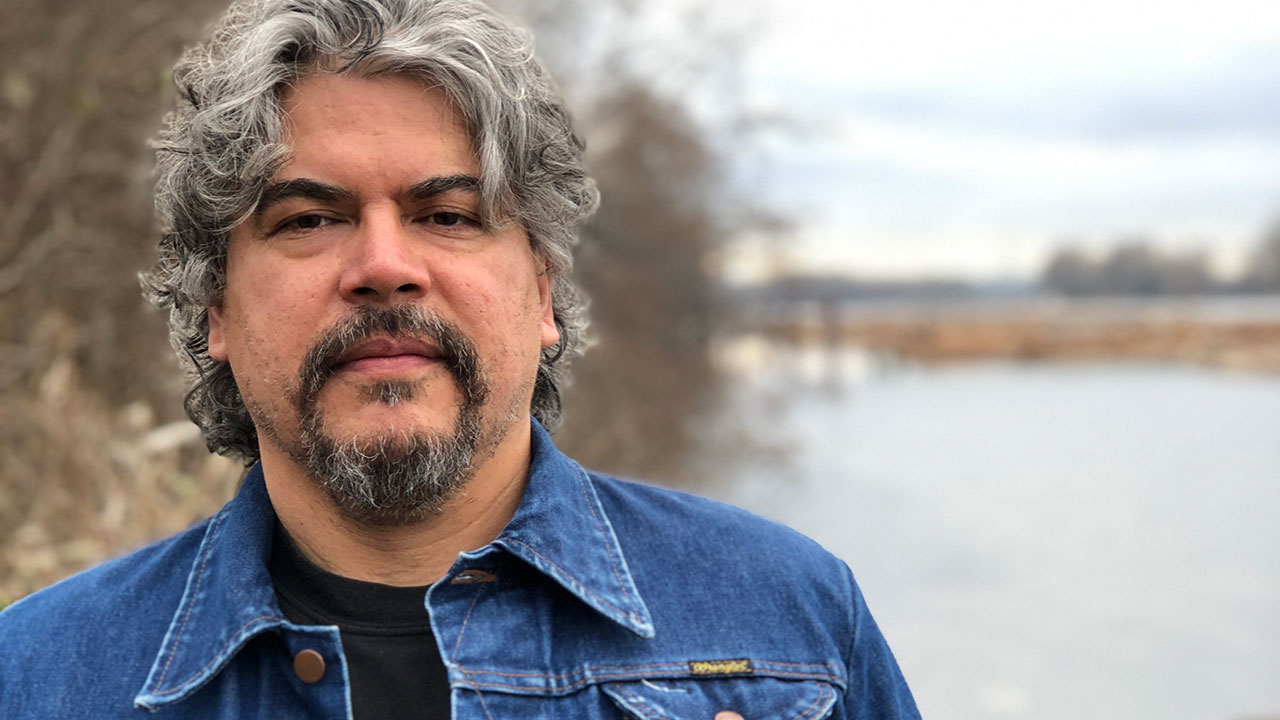
SN: Do you find that the audience, if you will, the consumer, interacts differently with the different types of art that you do?
BJ: Yeah, definitely. I use a lot of very common objects that people can recognize on a day-to-day life. I find that a really good way to bring people into a conversation about art and ideas. And it’s also just for me, I’m continuing a tradition of working in terms of using what’s in my immediate environment. So, let’s say back in the day a lot of Indigenous artists would have used animal hides or items in nature. Well, I’m kind of doing that but with contemporary products and stuff that I buy at Canadian Tire.
SN: What’s the intersection between sports, art and our culture?
BJ: Sport fulfills the very basic human need for ceremony, and that used to take place in many different cultures on a much smaller scale, very locally. Now I think that takes place with mass media and professional sports for a lot of people. I found that interesting and so I made certain artworks playing on that, like the jersey. Some people are interested in sports and not art or the art museum, so I wanted to make the space something that was more accessible to people by turning it into a gymnasium.
[snippet id=4725691]
SN: That commentary that more people are interested in sports now than in art. Does that disappoint you in a way? Does that trouble you?
BJ: Well, I grew up fairly remote within Northern B.C., and there was very little access to a lot art culture, art museums. The emphasis was always either towards popular culture or sports.
Those are two things that I invested a lot of time in growing up, just like lots of Canadian kids. I think it’s very different for kids who grew up in metropolitan areas, and it’s different now with accessibility to things for kids thanks to the internet. But for me, I was uncomfortable in art museums for a long time. I’ve never really forgotten that. So, I think my work somehow responded to that in some way.
SN: Interesting. To try and make it feel like a more welcoming space?
BJ: I guess. I mean, I’ve never really thought of that until recently, but it’s kind of maybe an unconscious thing.
SN: It’s fascinating that you looked at the space and immediately thought of the gymnasium. What does the gymnasium mean to the Indigenous community?
BJ: A lot of communities, especially in remote communities, it’s a social space more than an athletics space. I would even maybe say that for just rural Canadians too. Like places that can function as community hall. They’re places where people gather. They’re places where people vote. They’re places where people have meetings. It functions as a multi-use space. I think for Indigenous cultures it’s also a place where they can practice pow-wow dancing or gatherings or certain types of traditional ceremony. And what I always found fascinating is that connection between the role of ceremony and sports.
SN: Is your artwork your way of using sports to give Indigenous culture greater representation?
BJ: I think making artwork is about my identity. I’ve gone through a very long process because, like a lot of Indigenous Canadians, I grew up both in and outside of my Indigenous culture. So, it’s taken a long time to kind of come to terms with that. And there’s a big sense of loss I think. I hate to use the term reconciliation because it’s just thrown around. I guess kind of like acceptance of how things have turned out and willingness to go forward. I mean, my artwork is not really about being a victim of assimilation. It’s about trying to move forward with all sorts of different references and influences.
[relatedlinks]
